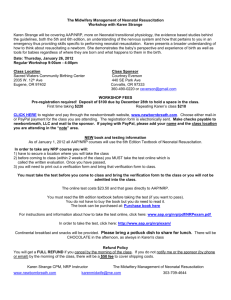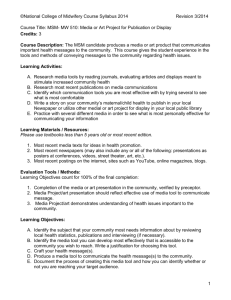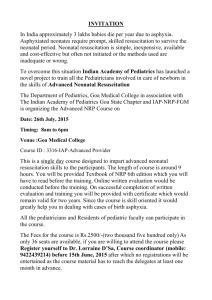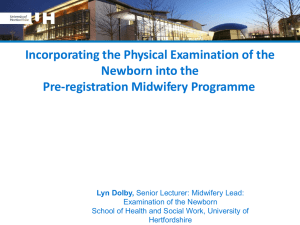Course Title: Newborn NRP - National College of Midwifery
advertisement
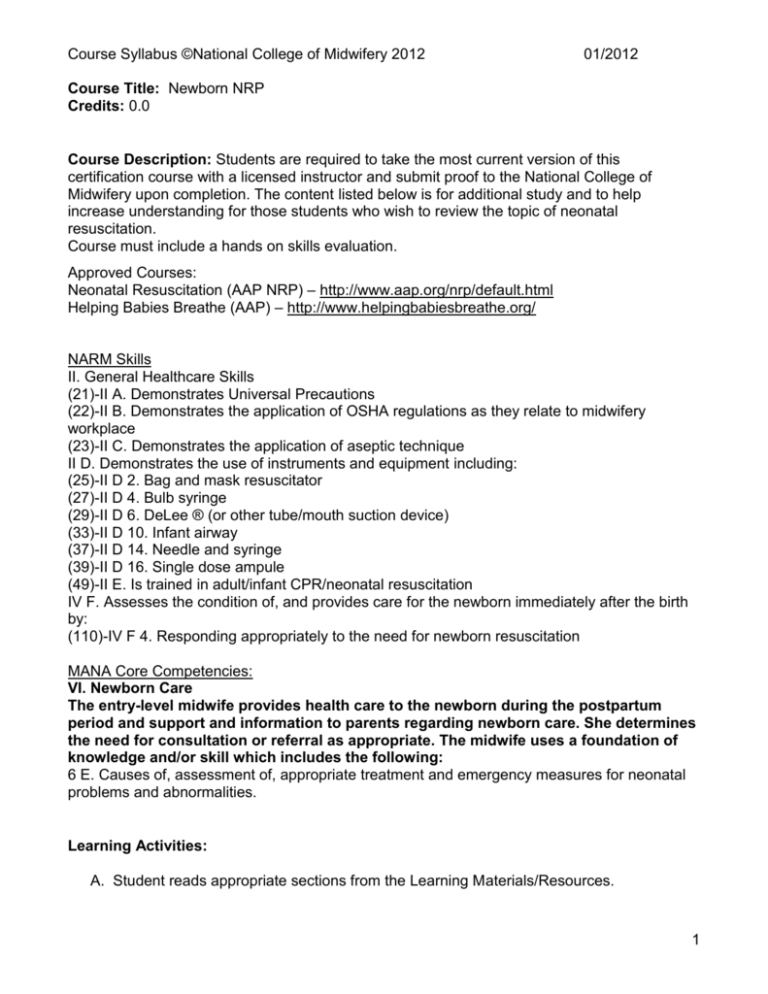
Course Syllabus ©National College of Midwifery 2012 01/2012 Course Title: Newborn NRP Credits: 0.0 Course Description: Students are required to take the most current version of this certification course with a licensed instructor and submit proof to the National College of Midwifery upon completion. The content listed below is for additional study and to help increase understanding for those students who wish to review the topic of neonatal resuscitation. Course must include a hands on skills evaluation. Approved Courses: Neonatal Resuscitation (AAP NRP) – http://www.aap.org/nrp/default.html Helping Babies Breathe (AAP) – http://www.helpingbabiesbreathe.org/ NARM Skills II. General Healthcare Skills (21)-II A. Demonstrates Universal Precautions (22)-II B. Demonstrates the application of OSHA regulations as they relate to midwifery workplace (23)-II C. Demonstrates the application of aseptic technique II D. Demonstrates the use of instruments and equipment including: (25)-II D 2. Bag and mask resuscitator (27)-II D 4. Bulb syringe (29)-II D 6. DeLee ® (or other tube/mouth suction device) (33)-II D 10. Infant airway (37)-II D 14. Needle and syringe (39)-II D 16. Single dose ampule (49)-II E. Is trained in adult/infant CPR/neonatal resuscitation IV F. Assesses the condition of, and provides care for the newborn immediately after the birth by: (110)-IV F 4. Responding appropriately to the need for newborn resuscitation MANA Core Competencies: VI. Newborn Care The entry-level midwife provides health care to the newborn during the postpartum period and support and information to parents regarding newborn care. She determines the need for consultation or referral as appropriate. The midwife uses a foundation of knowledge and/or skill which includes the following: 6 E. Causes of, assessment of, appropriate treatment and emergency measures for neonatal problems and abnormalities. Learning Activities: A. Student reads appropriate sections from the Learning Materials/Resources. 1 Course Syllabus ©National College of Midwifery 2012 01/2012 B. Student answers the questions listed in the Learning Objectives by researching the Learning Materials/Resources for the course and correctly cites the sources and page numbers for each of their answers. C. Student presents answers the questions listed in the Learning Objectives for review by preceptor. D. Student participates in preceptor elaboration/discussion of Learning Objectives. E. In the case that the required texts are more than 5 years old, the student must research, prepare & present a summary of current best midwifery care/practices appropriate to a topic covered in this course from a current journal article/study, less than 5 years old. F. Recommended Role-playing and/or Clinical Interactions Note: The clinical requirement of NARM /Clinical Skills is completed at any time throughout the ASM apprenticeship during actual clinical practice and is NOT a requirement to complete this academic course. Activities specific to NARM skills learned in this section: 1. NRP is to be completed as a course with a licensed instructor resulting in certification by a recognized agency. 2. Courses completed online are not acceptable. 3. Upon successful completion of this course the student must submit a copy of both the front and back of the certification card to National College of Midwifery in order to receive credit. 4. This certification must be kept current and renewed in order to be eligible to take the NARM Exam and to graduate. 5. Practice NRP with a doll and the equipment that you are most likely to use during an actual resuscitation. 6. Practice turning the oxygen tank on and off. Learning Materials / Resources: Please use textbooks less than 5 years old or most recent edition. 1. Neonatal Resuscitation (AAP NRP) – http://www.aap.org/nrp/default.html 2. Helping Babies Breathe (AAP) – http://www.helpingbabiesbreathe.org/ 3. Bloom, Ronald, et al. Neonatal Resuscitation Textbook. 5th edition. American Academy of Pediatrics. 2006 2 Course Syllabus ©National College of Midwifery 2012 01/2012 4. Thureen, et al. Assessment and Care of the well newborn. 2nd ed. Elsevier Saunders. 2005. 5. Fraser, DM, et al. Myles Textbook for Midwives. 15th ed. Churchill Livingstone Press. 2009. 6. Tharpe, Nell and Farley, Cindy. Clinical practice guidelines for midwifery and women’s health. 3rd ed. Jones and Bartlett publishers. 2009 7. Varney, Helen. Varney’s Midwifery. Fourth Edition. Jones and Bartlett Publishers. 2004 8. Frye, Anne. Holistic Midwifery: A Comprehensive Textbook for Midwives in Homebirth Practice, Vol. 2: Care of the Mother and Baby from the Onset of Labor Through the First Hours After Birth. Labrys Press. 2004. th 9. Weaver, Pam and Evans, Sharon K. Practical Skills Guide for Midwifery, 4 Edition. Morningstar Publishing Co. Wasilla. 2007. 10. MEAC Abbreviated NARM Skills Form. 11. MANA Core Competencies for Midwives 12. Midwives Model of Care®. 13. Students must find 1 article/study less than 5 years old. Recommended internet links as needed for latest developments in midwifery care: The Cochrane Collaboration EBSCO National Library of Medicine PubMed Medline SCIRUS Medscape World Health Organization Evaluation Tools / Methods: Minimum passing grade for each course is a cumulative 80% / B-. Students and preceptors are encouraged to work together until the student masters the information. Final grade for the course is based on preceptor evaluation of the following: A. Learning Objectives count for 80-90% of the final grade. The preceptor evaluates each answer based on three elements: 1. Answers should reflect a thorough review of current literature regarding best current practices in midwifery care. 3 Course Syllabus ©National College of Midwifery 2012 01/2012 2. Each answer should be formed in the student’s own words or paraphrased from the text. The answer should be minimal, not a re-write of the entire text, but enough to show appropriate comprehension of the learning objective. 3. Student identification of sources and page numbers for each of the Learning Objectives. (Preceptor should do a random check to determine that sources cited are correctly identified.) B. Summary of current journal article / study counts for 10% of the final grade in the case that other scholarly resources used are more than five years old. C. Exam counts for 10% of the final grade. Course credit: One Academic credit equals approximately 15 hours of formal time plus 30 hours of additional study or homework. Formal time is defined as the amount of time taken to answer the Learning Objectives to the level of 80% and to complete any learning activities to the preceptor's satisfaction, including any time spent face to face with the preceptor. Informal time includes any time spent actively reading relevant sources and textbook/s, researching Learning Objectives, and studying for examinations. Learning Objectives: A. The student must research, prepare & present a summary of an aspect of current best midwifery care/practices appropriate a topic from this course from a current journal article/study. B. Student answers the questions below and cites the sources and page numbers. 1. Explain why it is possible to identify only 60% of the infants who will need resuscitation at birth. 2. Explain how this affects preparation for neonatal resuscitation. 3. Discuss how neonatal resuscitation skills can be obtained. 4. Cite the age by which the majority of newborns establish respirations. Describe the physiologic process by which this takes place. 5. Explain why preterm or asphyxiated newborns might require significant intervention by skilled resuscitators. 6. Explain how hypoxia and acidosis interfere with the circulatory changes that must take place for survival outside the uterus. 7. Name some other factors which can depress respiration and how. 8. Name the three physiologic signs on which the identification of the newborn in need of resuscitation are based and why. 4 Course Syllabus ©National College of Midwifery 2012 01/2012 9. Describe how to set up for resuscitation including the preparation of the equipment and the rationale for each. 10. Describe how to determine the size of ET tube you will prepare and how the size of the tube relates to the estimated fetal weight for each. 11. The asphyxiated newborn may need increased pressure to achieve ventilation in the first few breaths. Explain why this is so, how it is achieved, and how much pressure a baby needs depending on its estimated weight. 12. Describe the rate at which neonates should be ventilated. How is over-inflation of the lungs prevented? How is patency of the airway maintained? How is the stomach kept from over-distention and what are the consequences if this is not done? 13. Describe when and why endotracheal intubation is necessary. 14. Explain how thick or particulate meconium is handled. Why? 15. Describe how placement of the ET tube is confirmed and how it is secured in place. 16. Describe each of the steps for neonatal resuscitation and the rationale for each. When is positive pressure ventilation required and why? When are chest compressions required and why? When is pharmacological resuscitation required and why? 17. Explain when pharmacologic resuscitation, chest compressions, and PPV are discontinued and why. 18. Describe the steps to be taken if the neonate fails to respond and give the rationale for each. 19. Explain when epinephrine may be given. What are concentration and preparation, the dosage and route, the rate, its effect, signs, follow-up, and special attributes to keep in mind? 20. Explain when volume expanders are indicated. Give the concentration and preparation, the dosage and route, the rate, effects, signs, and follow-up. 21. Explain when sodium bicarbonate is indicated. Give the concentration, preparation, dosage and route, rate, effects, signs, and follow-up. 22. Explain when naloxone hydrochloride is indicated. Give the concentration, preparation, dosage, route, rate, effects, signs, and follow-up. 23. Describe how the newborn that has been resuscitated is followed and why. 5
